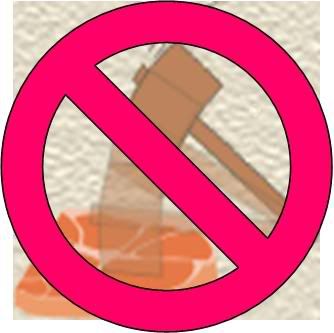In Miss Eagle's family home, there were two cookery crimes. One was beating meat with a mallet or a rolling pin with the aim of tenderizing it. The other was pricking sausages prior to cooking in the belief that this would prevent sausage meat oozing from its skin. You see, dear Reader, Miss Eagle's father was not only a great cook - as was her mother - but he was a trade-qualified butcher in the early part of the 20th century when the training was quite extensive. On beating steak to tenderize it
Jack O'Carroll, Miss Eagle's father, believed that no amount of beating could make a tough steak tender. In fact, one of the effects of beating steak was to expel the juices from the steak which tenderized it during the cooking process. How to get a tender steak:
- Choose a cut of steak appropriate to the cooking process. For instance, topside and round steaks are not grilling steaks. A corner piece of topside makes a very good roast. Sliced topside and round steak are best cooked slowly in casseroles, stews, and curries. Similarly, one would not bother to use Scotch or Rib Fillet or Eye Fillet in a casserole. These cuts are best suited to grilling or pan frying (dry frying). Rump Steak is quite versatile. It is a superb grilling steak. As a whole rump, it can be a beautiful roast. Sliced, it can go well in a casserole. However, rump is usually more expensive than topside or round so one would not bother using such a cut in a casserole when a less expensive cut would do as well.
- Understand how to cook meat. Understand the cuts of beef. In this day and age, there is a great demand for lean beef. Fat marbled through beef is what contributes to its tenderness. The way a side of beef is hung by a butcher and the length of time it is aged contributes to its tenderness. Miss Eagle, as her father and grandfather (a livestock auctioneer) before her, has a preference for beef from Poll Shorthorn cattle. Indeed, Miss Eagle believes the beast should not have to walk far to eat and its food should be unstinted lush green grass. Such a beast produces beef that is not red but purple with creamy specks of fat marbled through it. Now that is tender beef.
On pricking a sausage to prevent it oozing
- In these modern times, sausage casings can vary from the natural product to the synthetic. Again, the secret is to learn about sausages. Know what a quality sausage is. And you can't go past a German butcher to teach you. Miss Eagle's paternal grandmother always had a German butcher hovering in the background.
- Learn how to cook a sausage. Pricking sausages does not prevent oozing if your sausage is cooked incorrectly or the casing of poor quality.
- To cook a sausage properly and well, pour a small quantity of Extra Virgin Olive Oil across the base of a heavy frying pan. Place the sausages in the pan. Turn them to coat them in oil. Then place them on the hotplate or burner and turn on the heat. Yes, start cooking the sausages cold and turn up the heat slowly and gently. Heat is applied slowly and gently so that the sausages adjust slowly to the cooking process. Only when the sausages have plumped up gently in this way can the heat be turned up further to complete the browning and cooking process. In this way, you will have a fat, juicy sausage which does not pop its skin.



1 comment:
Miss Eagle, allow me to congratulate you on this post. Myths exposed and correct explanations given. Reminds me of a story I read once. Man (who never cooked) was going to have to fend for himself when Wife was (unusually) going to be OUT. He was to have sausages. She said "dont forget to put a fork in the sausages before you cook them". Came home unexpectedly early, to find a frypan on the stove with several sausages cooking in it - each one impaled by a fork.
Post a Comment